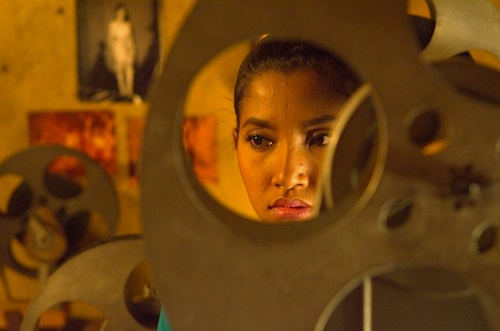By Joe Bendel. Approximately 300 films were produced during the “Golden Age” of Cambodian cinema, but only thirty survived the barbarity of the Communist Khmer Rouge. That means one missing reel of an otherwise intact Cambodian feature is as maddeningly and tantalizingly significant as the legendary lost bits of The Magnificent Ambersons. One young Cambodian woman sets out to find or recreate such footage, but her search will bring her face-to-face with history both national and personal in Sotho Kulikar’s The Last Reel, which screens as part of the 2015 New York Asian Film Festival.
Sophoun is at a crossroads. Disinterested in school and disinclined to submit to her military father’s arranged marriage, she has been avoiding home life as much as possible. Unfortunately, that also means she has neglected her increasingly age-addled mother. Having fallen in with a delinquent crowd, she is forced to take refuge one night in a decrepit old movie theater. Much to her surprise, she finds a movie poster with her mother’s face prominently displayed.
As she learns from the standoffish proprietor, her mother was once a movie star, known as Sothea and he has the only print of her final film. In fact, he compulsively screens it every night, but alas, it is incomplete. Yet, that initially adds to its allure for Sophoun. Did her mother’s character choose the prince she was betrothed to, or the peasant who saved her from a jealous nobleman?
Even with the former-filmmaker/projectionist’s help, Sophoun has no luck tracking down either the missing reel or the original screenplay. However, her bad boy boyfriend and the university film department will help recreate the conclusion. At this point, they head into the field, which turns out to be part of the Killing Fields. As her reluctant movie mentor’s memories come flooding back, things start getting interesting for all concerned.
The loss of Cambodia’s cinematic heritage is a true tragedy, especially since those Angkor costume epics look so amazing. The Long Way Home, the film-within-the-film, gives us an enticing hint of what they were like. However, Sotho and screenwriter Ian Masters incorporate Sothea’s film into the narrative in even deeper ways. Structurally, Reel is a very ambitious work—and they largely pull it off. There are a whole heck of a lot of third act revelations, but rather than feeling forced, they organically represent realities of post-Pol Pot Cambodian life.

Any film that brings Dy Saveth (considered the only living survivor of the Golden Age) back onto the silver screen earns its props right there. She is downright haunting as Sothea, especially given the meta-significance of her character. Nevertheless, it is Ma Rynet who must carry the film, being on-screen almost every second. Fortunately, she has more than the necessary energy and presence required. There is a certain unpolished naiveté to her performance that works quite well in the context of Masters’ narrative. Yet, it is prominent filmmaker Sok Sothun who really lowers the boom as the physically and spiritually scarred projectionist.
At times, Reel feels overstuffed with subplots and side-characters, but Sotho manages to tie them all up neatly enough to satisfy the demands of cinema. This film was necessarily a learning experience for many trying to rebuild the Cambodian film industry, so it is rather exciting to see it all come together down the stretch. The final product is sort of like a profoundly serious Cinema Paradiso. Highly recommended for those who care about the preservation and advancement of cinema as an art-form, The Last Reel screens this Sunday (7/5) at the Walter Reade, as part of this year’s NYAFF.
LFM GRADE: B+
July 3rd, 2015 at 12:32am.